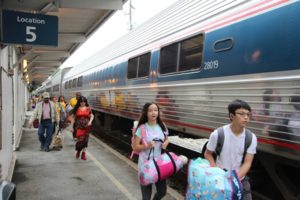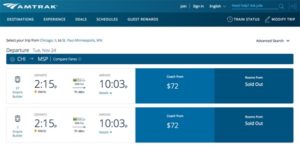
In an Aug. 6 Trains News Wire interview, Amtrak President and CEO William Flynn and Stephen Gardner, senior executive vice president and chief operating and commercial officer, addressed the company’s thinking on long-distance service cuts planned for October. The interview was conducted before Amtrak informed employees of specific schedule plans [see “Amtrak sets schedules for triweekly long-distance operation,” Trains News Wire, Aug. 13, 2020] and released details of the metrics it would use to judge when to resume daily operation [see “Amtrak releases criteria for restoring long-distance service,” News Wire, Aug. 11, 2020].
Meanwhile, this weekend the company began blocking sale of sleeping-car accommodations on days when trains wouldn’t run under the triweekly plan, while continuing to sell coach seats on those dates.
A 1995 Amtrak attempt to save money by cutting long distance frequencies from daily to triweekly failed to fully envision the financial costs of such moves [see “Former Amtrak president revisits previous move to triweekly service,” News Wire, Aug. 3, 2020]. But Gardner contends this case is different.
“Three days per week is not a good solution in a normal revenue environment [but] we’ve done our homework,” Gardner said, responding to a question asking how a projected $150 million in savings was calculated and whether route restoration costs were included. “We feel good about being able to save significant dollars for a limited period, and that makes sense because demand is so low.”
In light of pandemic-related losses, Amtrak has requested $1.475 billion in supplemental funding to go with its regular $2.04 billion budget request. While a bill passed by the House would offer some $10 billion in funding, the Senate has yet to act.
“I don’t envision a situation where Congress is giving us something above the $3.5 billion,” Gardner said, “and they are not being fairly clear about what they expect in terms of operating levels.”
Flynn said the company had not developed specific contingency plans for operating a daily long-distance network.
“If Congress directs us to operate a seven-day service we will,” Flynn said. “If they don’t [provide funding], we’ll have to make additional cuts to the workforce, and it would certainly affect our capital plans and suggest reductions on the Northeast Corridor and perhaps elsewhere on the national network.”
Gardner explained, “We get funded in two accounts, so the primary source we go to immediately is to slash capital in the national network because the operating will be in the national network. We can’t use Northeast Corridor [money] because that is given to us for capital for the NEC.”
For fiscal 2020, national-network service received $1.3 billion, while the Northeast Corridor was allocated $700 million. The funding split was developed under the assumption that Northeast Corridor operations would supply the greatest cash flow [the logic behind Amtrak’s frequent contention that NEC operations nearly break even]. But the biggest funding shortfall on a percentage basis during the pandemic is a result of the precipitous drop in Northeast Corridor ticket revenue resulting from reduced service and demand.

“It’s possible to have a transfer in an emergency situation,” Gardner said. “We’re thinking about these options; we’re not here to give you a list of exactly what we would do.”
Flynn said, “If we have supplemental funding that can support the seven-day service operation and the direction to do so, we’ll keep it operating; we’ve talked through that.”
Congress express concerns
Lawmakers have sent three separate letters to Flynn urging Amtrak to rethink its strategy [see “Senators seek more details on Amtrak service, job cuts,” News Wire, June 29, 2020], and the appropriations bill passed by the House specifically tied funding to maintaining daily levels of long-distance service.
Meanwhile, a source tells Trains News Wire that the service-restoration plan released earlier this month replaced several earlier versions that were rejected by Capitol Hill staffers. They proposed using metrics including airport bookings along long-distance routes and systemwide percentage drops in ridership since April, and incorrectly characterize long-distance ridership as week from October through May, overlooking the strength of holiday-period travel.
Those plans also did not consider passenger-miles, or weigh the relative revenue strengths of Amtrak’s three types of service — long distance, Northeast Corridor, and state-supported.
In July 2020, overall Amtrak revenue was down 82% from the same month in 2019, but the 15 long-distance trains contributed 54% of the ticket revenue. The long-distance income decreased 61% with only minimal frequency reductions (cuts to the Silver Star and Silver Meteor). Northeast Corridor revenue for the money, meanwhile, was down 93% and state-supported revenue was off 83%. The figures have been similar since the pandemic began.
Sleeping car inventory reflects planned cuts
Amtrak’s website began reflecting the planned reduction in long-distance service this weekend. On the four days when trains won’t run after cuts begin Oct. 5, all sleeper accommodations are listed as “sold out.” Coach inventory can still be booked, at prices comparable to the same periods in previous years.
While the company informed employees of its specific schedule plans for triweekly operation, it has yet to make a public statement regarding the service reductions. Reservation agents typically notify already-booked passengers with their options before changes are formally announced.
The continued availability of coach seats on all days may be a hedge reflecting the prospect that Congress does, in fact, mandate continued daily operation. But in the meantime, sleeping car revenue on those dates won’t be finding its way onto Amtrak’s books.
Update, 2:05 p.m. CDT: Following the publication of this article, Amtrak has issued this statement:
“Starting August 17, we are sharing with customers our new schedules for reduced Long Distance train frequencies that are planned to go into effect this October. Making these new schedules available now will help customers plan for future trips and adjust existing trips impacted by these changes. These reductions in frequencies are a result of the dramatic reduction in travel demand due to the Coronavirus pandemic and follow steps we’ve already had to make across our other services lines across our network,” said Stephen Gardner, Amtrak Senior Executive Vice President and Chief Operating and Commercial Officer. “We are committed to assessing the travel needs continuously and to restoring service levels when appropriate.
“We regret the impact of these planned changes on our customers, employees, and communities across the nation and we hope to restore some or all of this service back to daily in 2021. But, with ridership down by 80 percent and more and Federal funding levels for Amtrak unclear for Fiscal Year 2021, we must take appropriate steps to align all of our service levels with current demand.”
A Passenger Service Notice regarding these changes is posted on Amtrak.com.
Additional information, including metrics to restore daily service, is also posted on Amtrak.com.













